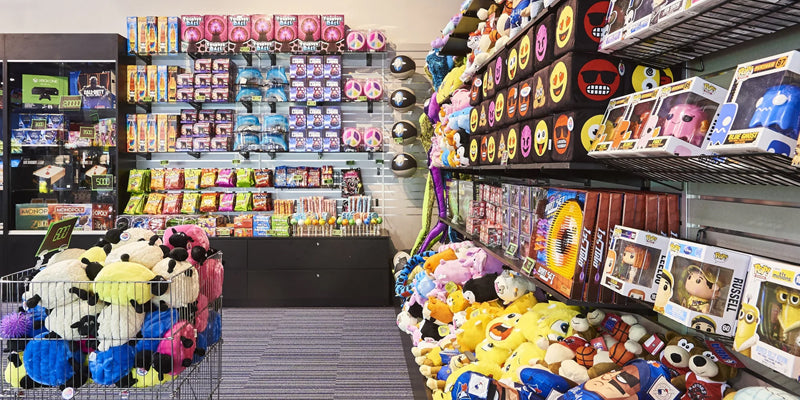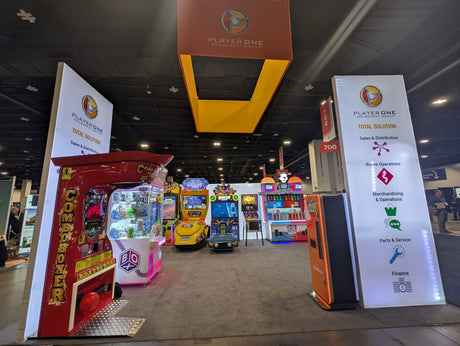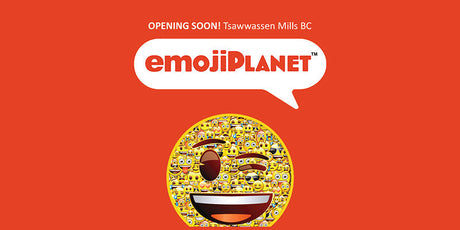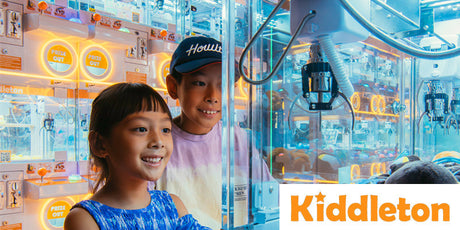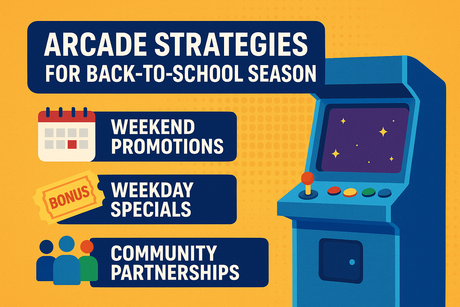Dans ce blog : découvrez comment les prix de base, les bonbons et les articles « wow » fonctionnent ensemble pour augmenter la consommation de billets, la fidélité des clients et les revenus dans les salles de jeux des centres de divertissement familiaux.
Promenez-vous dans n'importe quel centre de loisirs familial (CAF) très fréquenté et vous remarquerez une tendance : les enfants se précipitent vers le comptoir de récupération avant même d'avoir utilisé leur première carte de jeu. La promesse de prix, petits ou grands, transforme les visites occasionnelles en séjours plus longs, en plus de jeux et en retours. Avec des chiffres cumulés depuis le début de l'année 2025 affichant des dizaines de milliers de récupérations sur seulement quelques références, les exploitants de salles d'arcade avisés savent qu'une sélection de produits bien pensée est aussi importante que la gamme de jeux elle-même.
1. La « règle du canard en caoutchouc »
Faible coût + forte capacité de collection = volume démesuré.
Les données de vente de P1AG le prouvent : deux assortiments classiques de canards en caoutchouc dominent le classement des ventes depuis le début de l'année. Pourquoi ? Les canards (et leurs cousins en peluche) répondent à trois déclencheurs psychologiques :
- Heuristique de gentillesse : les couleurs vives et les formes potelées semblent immédiatement familières.
- Campagne de collecte – des costumes et des couleurs frais transforment un seul prix en une chasse au « j'en ai besoin de tous » (il existe des dizaines de styles de canards, pas seulement six).
- Prix du billet idéal : les enfants peuvent en gagner un rapidement, ce qui renforce la boucle de dopamine.
Conseil de pro : au lieu de procéder à des révisions saisonnières complètes, souvent délicates pour nos équipes de route, proposez des variantes en édition limitée plusieurs fois par an pour garder les collectionneurs en haleine.
2. Deuxième couche : bonbons et jouets en capsules
Si les canards sont ceux qui vendent le plus d'unités, les bonbons et les capsules de 5 cm arrivent en deuxième position en termes de volume de ventes. Leur rôle est crucial :
- Satisfaction instantanée pour environ 5 à 15 billets (de nombreuses capsules de 2 pouces dans les emplacements P1AG sont vendues via des kiosques Prize Hub plutôt que via un comptoir avec personnel, permettant aux enfants de se servir eux-mêmes même lorsque les files d'attente sont longues).
- Des suppléments à marge élevée que les parents refusent rarement.
- Zone tampon de circulation pendant les heures de pointe : les enfants attrapent et partent, libérant ainsi les files d'attente au comptoir pour des conversations plus approfondies.
Astuce d'affichage : utilisez des bacs en acrylique à plusieurs niveaux, à hauteur des yeux des enfants. Placez une petite bande LED en dessous pour faire briller les couleurs des bonbons et augmenter les prises spontanées jusqu'à 18 % (selon l'analyse comparative de l'IAAPA).
3. Le point idéal du milieu de gamme
Une fois les clients passés des bonbons impulsifs à la catégorie intermédiaire, ils atterrissent dans la catégorie intermédiaire : colliers LED, peluches de marque et gadgets anti-stress, dans la gamme de prix de 50 à 250 $. Ces références :
- Encouragez une deuxième série de jeux (« Il me manque 40 billets, maman ! »).
- Offrez une valeur perçue plus élevée sans écraser le coût des marchandises vendues.
- Créez une monnaie sociale : les enfants montrent leur bracelet lumineux à leurs amis, et leurs amis glissent aussi.
Conseil de stock : changez de modèles tous les trimestres, mais conservez au moins deux best-sellers intemporels pour assurer la continuité pour les clients qui reviennent.
4. Créez un mur d'épargne
Les prix importants (drones, mini-projecteurs, consoles de jeux) représentent moins de 5 % des ventes unitaires, mais suscitent un engouement démesuré. Ils :
- Fidélisez vos enfants : planifiez plusieurs visites pour accumuler des billets électroniques.
- Rechargements de cartes Boost : les parents rechargent les cartes dès qu'ils voient les yeux de Junior sur la PlayStation 5.
- Fournissez une preuve sociale : une console échangée est un panneau d'affichage ambulant pour votre salle de jeux.
Placez ces articles sur un mur « waouh » haut de gamme, avec un éclairage vers le haut et des valeurs de ticket claires. Même si peu de clients les utilisent, l'attrait aspirationnel augmente les dépenses globales.
5. Rythme de réorganisation piloté par les données
Être à court de canards le week-end précédant les vacances de printemps ? C'est pénible. Commander trop de peluches d'Halloween et les conserver jusqu'en janvier ? C'est tout aussi pénible. Utilisez la vitesse de vente du dernier trimestre :
Re‑order Point = (Average Weekly Unit Sales × Lead Time in Weeks) + Safety Stock
Grâce aux rapports hebdomadaires, vous saurez deux semaines à l'avance quand réapprovisionner les produits de base et quand laisser un produit lent à se développer tranquillement.
6. Produits dérivés sous licence : la formule infaillible de Tom Clark
« Mettez un visage familier dessus, et les billets s'envolent. » Cette phrase rapide de Tom Clark, directeur des produits dérivés et des marchandises chez P1AG, illustre pourquoi les prix sous licence peuvent surpasser les produits sans étiquette, surtout lorsqu'ils sont programmés pour coïncider avec les sorties de films, les séries éliminatoires ou les lancements de nouveaux jeux.
Des classiques Nintendo comme Mario et Pokémon au jeu rapide Sonic de Sega, les icônes nostalgiques du jeu vidéo sont immédiatement reconnaissables. Ajoutez-y des objets de sport professionnel : mini-sticks NHL, doigts en mousse MLB, ballons de football NFL ou porte-clés Coupe du monde, et vous couvrez tous les âges sur une seule étagère.
Pourquoi ça marche
- Connexion instantanée – Les invités ont déjà de l’affection pour les personnages et les équipes qu’ils connaissent.
- Collectionnabilité – De nouvelles itérations, de nouveaux uniformes ou des éditions limitées de tournois incitent les fans à revenir.
- Un attrait intergénérationnel – Les parents ont grandi avec Mario ; les enfants le découvrent maintenant. La fidélité sportive s'étend à toute la famille.
7. Pops saisonniers et événementiels
Un micro-lot de peluches rouges et vertes en décembre peut générer une augmentation de 22 % des ventes unitaires par rapport à la même période l'an dernier. Limitez vos achats saisonniers (4 à 6 semaines de stock de couvertures) afin de préserver votre trésorerie et de créer des pénuries.
Transformez l'inventaire en expérience
Les produits dérivés d'arcade ne sont pas seulement une dépense : ils prolongent le parcours client et génèrent des revenus récurrents. En optimisant votre offre avec des incontournables à forte valeur ajoutée (bonjour les canards en caoutchouc), en superposant des friandises gourmandes et en mettant en avant des offres exceptionnelles pour faire des économies, vous transformez chaque visite au comptoir d'échange en plus de clics, en recharges plus fréquentes et en familles plus heureuses.
Principaux points à retenir pour les opérateurs :
- Rafraîchissez, ne remplacez pas : faites tourner les couleurs et les variantes pour que les meilleurs SKU restent intéressants.
- Marchandises classées par niveau : des repères visuels clairs aident les clients à s'auto-segmenter et à raccourcir les files d'attente.
- Laissez les données piloter les commandes : les rapports hebdomadaires sur la vélocité évitent les ruptures de stock et les radiations.
- Investissez dans un éclairage d’affichage : une bande LED à 75 $ peut surpasser un test de produit à 750 $.
- Faites la promotion de vos victoires sur les réseaux sociaux : partagez des selfies gagnants pour attiser le FOMO et le marketing gratuit.
Mettez en œuvre ces tactiques et regardez votre stratégie de produits dérivés d’arcade transformer les centimes en sourires, et les sourires en EBITDA en plein essor.
Prêt à optimiser votre mix de rachat ?
Les experts FEC de Player One Amusement Group analysent en temps réel les délais de vente et d'approvisionnement. Le merchandising étant intégré à notre programme de partage des revenus , nous gérons l'approvisionnement, le stockage et le service pour chaque site partenaire. Vous vous concentrez ainsi sur l'expérience client, tandis que nous gérons le compteur de prix. Parlons de la maîtrise du merchandising.

